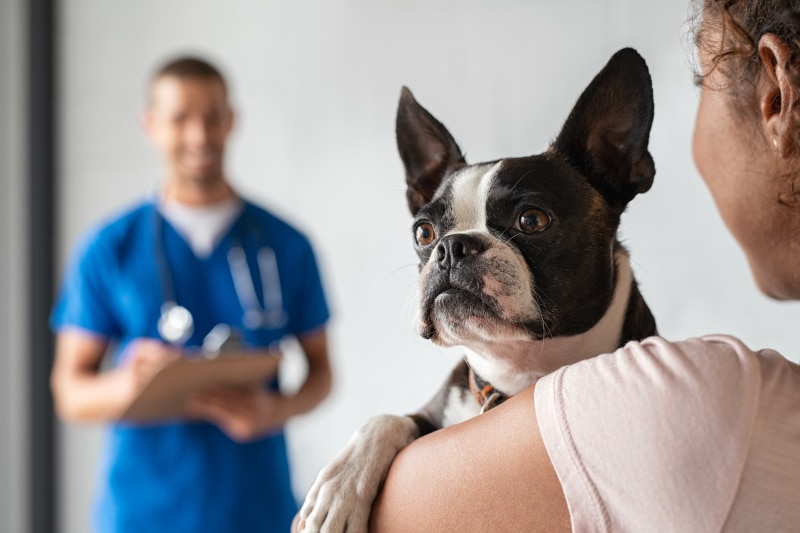How To Help Dogs With Separation Anxiety

You’re just getting back home from a grocery run. As you walk up to the door, you can hear your young pup howling away inside. At the sound of your keys turning in the lock, the howling stops. Just before you walk inside with your bags, your next-door neighbor calls over to you.
He wants to let you know that your pooch was howling away constantly for the last hour and wishes to remind you that you said you promised to do something about it.
As you walk in to put your groceries away, you are dismayed to find that the house is a bit of a wreck. The trash can in the kitchen is overturned with smelly garbage all over the floor. A chair is overturned, a couple of magazines in the living room look like they were shredded. When you go into the bathroom, the toilet paper is covering the floor in draping layers.
You were only gone for an hour, but your neighbor is already upset with you again, and your house is a mess. You look at your pup, who sits looking up at you innocently, calmly, waiting for a queue.
This may seem like a dramatic scenario, but it’s one that’s common enough in many pet parents. Everything’s fine when you’re home, but when you’re away it seems like all hell breaks loose, and your beloved pup is at the center of it.
Is she just being bad? Or is there more to it than your dog’s behavior?
Separation anxiety in dogs is a big frustration for most dogs, and there actually is quite a lot more to it than your dog just “being bad”. In this article, we’re going to talk about separation anxiety in detail as a real behavioral disorder that can be diagnosed and addressed in dogs. We’ll go over some tips at home, calming supplements, as well as therapeutic strategies, and when to get your vet or a behavior specialist involved.
Are Behavioral Problems in Dogs Really Disorders?
The short answer is that not all behavior issues we see in dogs are true disorders. A behavioral problem can result from a particular situation, scenario, or environment and may only be short-lived. But if we’re seeing a continued, reliable pattern of a problem that extends for weeks if not months, a true disorder is more likely.
According to the ASPCA, behavioral problems are one of the top reasons that lead pet owners to relinquish their dogs to shelters. Just like people, many dogs do have actual behavioral disorders that they can be diagnosed with, the most common category being separation anxiety.
Many pet parents might wonder what a dog’s anxiety is caused by, but there could be many triggers to a dog’s underlying anxiety like a traumatic event. That’s why it’s so important to take the time to understand what’s going on with dogs with separation anxiety, and find out what those triggers are, so you can work on ways to help instead of getting more frustrated.
Separation anxiety is one such true disorder. It’s been seen and studied thoroughly for long enough that veterinary professionals and trainers alike know how to recognize it.
Signs Of A Dog’s Separation Anxiety

Separation anxiety is a disorder where a dog may engage in a variety of undesirable distress behaviors in the absence of his human companion.
Signs of separation anxiety may be very mild and only consist of a stress response that might be a little barking or whining that lasts for 10-15 minutes after you leave.
But at its worst, dogs suffering separation anxiety may bark and howl incessantly, engage in destructive behaviors like chewing up magazines, furniture, and upending the trash, and inappropriate elimination around the house even when completely house trained.
Dogs with separation anxiety can even get a panic attack and hurt themselves to escape confinement in the sudden absence of their owners, which can lead to more medical problems.
The important distinction that distinguishes separation anxiety from other anxiety behaviors is that these problems only occur when you’re not home.
While it’s a myth that cats are all antisocial creatures (my own three can easily disprove that idea), they can be quite content to sleep for 12-14 hours out of the day, use the litter box when they need to, and amuse themselves with toys. This isn’t the case with dogs. They need a lot more personal quality time.
Couple the time and scheduling issues many of us have with the needs a dog has, and it’s not hard to see why separation anxiety can quickly become such a problem.

Dog Separation Anxiety
Like many behavioral disorders, there can be many underlying causes for separation anxiety. It can be puppy behavior in pups who are poorly socialized, making their entire social structure reliant on the presence of one person. It may also develop in older dogs who are adopted out of situations of neglect and abandonment.
Some dogs may also have a genetic predisposition for anxiety in general, and separation is simply one way that it manifests.
We may also see separation behaviors develop as part of a need for attention, developing from boredom and a lack of needed social interaction. This last one may not be a true disorder, but is very hard to distinguish and may be addressed in a similar way to a true disorder, at least initially.
Treating Separation Anxiety
There are a lot of methods to approach separation anxiety, but the best is one that comprehensively combines several approaches. No single method is likely to be successful on its own. You can’t just buy a crate, put your dog in it, and expect good behavior from a happy dog.
You also can’t just medicate or sedate a dog and expect a problem to be fixed either. So how exactly do you help dogs with separation anxiety?
Prevention: The First Place to Start
Prevention is often a topic we end with, but we’re going to start with it here, because it can be the most important, especially with young dogs.
Separation anxiety doesn’t always develop in dogs who have been neglected or abused, as many might think. In fact, it can often happen with a dog acquired as a puppy in a loving home with plenty of toys, attention, and regular meals. But even in good homes, proper socialization can be overlooked, as well as making sure a dog learns to be comfortable with some alone time.
It’s important to condition a young puppy to be around many different social situations, environments, people, and animals. Engaging in this conditioning regularly prior to six months of age is best, as many behaviors become more fixed the closer we get to a year of age.
We certainly want to make sure we’re balancing social development with proper preventative health, so until core vaccines like distemper and rabies are fully delivered, make sure to plan social dates with friends and family whose dogs you know are well-vaccinated and healthy.
It’s also important to ensure these experiences are positive. Make sure to have your young pup interact with dogs who are a little bit older but calm and tolerant of a crazy, energetic puppy. Your puppy is more likely to learn appropriate behaviors and social queues from these types of interactions.
Also ensure that if there is another family member at home, that they interact as equally as possible. Make sure not just one person feeds, plays, or walks your pup. This can help prevent a dependency and attachment to one person at home which can lead to separation anxiety.
The next big part of prevention is ensuring good crate training.
Crate-Training 101
Crate-training is a very important part of an upbringing for any pup and this is a fairly wide-spread opinion among veterinarians and trainers alike.
Some folks may be opposed to the idea of locking their pup up in a cage, especially when they’re not home.
But if we do the training properly and effectively, a crate is not a cage but a safe space your pup can feel comfortable in and call his own dog home.
Crate-training has come about over the last quarter century or so as dog owners have transitioned into pup parents, treating their furry friends more as family members. I think it’s always interesting that if you read older children’s books from the mid to late 20th century that involve dogs, like Clifford or the Berenstain Bears, you’ll notice that outdoor dog houses are featured prominently. Even our friend Snoopy from Peanuts fame lived outdoors in a dog house.
But over the years, the outdoor dog house has largely fallen out of favor as folks want their pup to live more closely with them and to be more connected as family members. You don’t keep your kids outside, so why would you keep your dog outside? Older minds would say “because he’s a dog, not a kid”, current perspectives would now say “she’s not just a dog, she’s my furry kid”.
But humans kids generally have their own room, even if they’re sharing one with siblings, that they can call their own. That’s their space.
The crate has evolved to take over this role as the safe, personal indoor space for a pup. And training him to utilize this space from a young age is extremely important. This is not just for our current topic of separation anxiety, but also for potty-training and for helping with some other unwanted behaviors like trying to escape confinement.

Other Non-Medical Strategies to Help with Separation Anxiety In Dogs
Crate training is one of the biggest parts of helping with managing separation anxiety or other anxious behaviors. When good training begins early, most dogs can feel safe and comfortable when alone and we can often eliminate destructive behaviors, barking, and howling.
But the crate alone isn’t always enough in helping with severe cases of separation anxiety in dogs. If you’re still having frustrations, there are some other things to consider before moving on to medical options.
Exercise
There’s nothing like good exercise to get out some excess energy. If your pup seems stir-crazy because she’s being crated for several hours during the day, make sure to include time for longer walks, jogs, or outdoor playtime as much as possible.
Also be sure to include interactive toys in your dog’s life like a puzzle toy stuffed with treats.
If you can’t be home to let your pup out regularly, there are many options now for dog walkers to come to your house and do this for you. Some folks have a family member or neighbor who are willing to do this. There are also now many businesses you can find online that specialize in dog-walking and pet-sitting.
Another great option to consider is a dog sitter or doggy daycare. Having your pup go to daycare even just a couple of times a week can provide social interaction with other people and dogs and provides some great opportunities for play and exercise.
Environmental Stimulation
Providing sources of amusement or mental stimulation for dogs while in the home alone can also help with dogs suffering from separation anxiety.
Some pup parents find that leaving some kind of background noise on while they’re gone can help. This might be music, the radio, or even the television. The sound of people’s voices, even if not your own, might help many dogs relax.
These familiar sounds can also drown out some of the scarier ones outdoors like sirens, car horns, landscaping equipment, and construction.
And as already mentioned, make sure to provide a couple of toys for your pup. Make sure they’re durable and not easily destroyed or ingested.

Medical Options for Dog Separation Anxiety
There are many situations where we might consider medical options to help address separation anxiety. If a puppy has had good, consistent training but we’re still seeing signs of separation anxiety, especially destructive behavior in the crate or break-out attempts, something to help your pup calm down is probably needed.
You may also find that, if you adopted an older dog who was not crate-trained or had a rough history, that drug therapy will be necessary to help her. Behavioral therapy is still important to employ, but you may find you need to involve more professional help as we’ll discuss soon, and that training has its limitations.
There are two main categories of medical therapy for separation anxiety. One is supplements and the other is anti anxiety medication.
Supplements
There are a couple of supplements that can promote a calming effect without being considered prescription strength. For mild cases, or situations where behavior modification and training is largely successful but we need a little extra help, I often try these out first.
Melatonin
Melatonin is a natural hormone produced by the pineal gland in the brain. The gland stimulates its production based on night/day cycles to help prepare the body for rest and sleep. Supplementing it can help promote a sense of calm.
Lower dose supplements like Calm Down with Ginger and Melatonin can be a good place to start. Higher doses purchased from the drug store should be first discussed with your veterinarian for proper dosing.
Thiamine (Vitamin B1)
Thiamine is sometimes called the “anti-stress” vitamin. Also called Vitamin B1, thiamine is one of the essential vitamins the body needs. When supplemented, some studies in people have demonstrated thiamine’s ability to help the body fight stress and develop a positive mental attitude. As a water-soluble vitamin, any excesses are peed out, which makes it pretty safe. It can often be found in combination stress-relief products like Quiet Moments or Calm Down.
L-theanine
L-theanine is an amino acid found naturally in green tea that can create a non-drowsy state of relaxation. There are a couple of commercial supplements available for pets specifically that are developed around l-theanine as a main ingredient.
Casein
Casein is a protein found naturally in human and cow’s milk. A more specific derivative of casein, called alpha-casozepine, has shown to promote relaxation in human babies and it has also been used for several years as an anxiety supplement for pets. Like l-theanine, it provides a non-drowsy state of relaxation.
L-Tryptophan
When folks think of tryptophan, many think about eating a lot of Thanksgiving turkey and then passing out shortly thereafter. While it doesn’t truly have this degree of effect (passing out after eating is more likely from the hefty blood sugar spike from all of the other food you eat), there is some truth in its ability to promote rest.
L-tryptophan is a precursor for serotonin, a neurotransmitter in the brain that promotes a sense of wellbeing and happiness. Serotonin, as it happens, is also a precursor for melatonin.
Plant-Based Products
There are numerous plants that are purported to promote rest and relaxation. Some of these include magnolia, phellodendron, ginger, chamomile, passion flower, and hemp seed. Like many supplement ingredients, some studies in people are promising, while others are conflicting.
While I can’t attest to the full efficacy of each one, there is likely some truth that they can have some beneficial effects, and even some synergistic effects when used together. While I wouldn’t go out and buy each one from the drug store and start adding them all to your pup’s food, smaller doses are fairly safe when found in combination products approved for pets.
Prescription Medications
In situations where separation anxiety is severe or if milder cases haven’t responded well to supplement therapy, your veterinarian may wish to discuss prescription medication options with you.
The two most common classes of long-term medications used are tricyclic antidepressants like clomipramine, and selective serotonin reuptake inhibitors (SSRIs) like fluoxetine.
When initially started, the effects of these types of medications are typically monitored for a few weeks. The thing to remember with these is that they can take some time to reach effective levels and they cannot simply be stopped and started again.
Because they do take time to be effective, it’s common to incorporate shorter-acting medications to help in the short-term during times of extra stress or anxiety. These can include medications like trazodone, alprazolam, and acepromazine.
We won’t go into much further detail with drug classes and the like, since it’s most important for your vet to decide what is best for your pup and to share in that decision process with you. In the same vein, it’s extremely important to never share any medications with your dog that you may have at home.
But we will talk about what our general goals are in prescribing these medications for pets. It’s most important to utilize the lowest effective dosage that makes a difference while balancing this with the most effective behavioral modification program.
For example, we may find for a particular pup, that separation anxiety is the only type he experiences and that a short-term medication during times of planned separation is all we need to use in conjunction with diligent training.
But in another pup’s case, she may have multiple situations that trigger fear or anxiety, making a short-term medication impractical. A long-term medication may be more beneficial, since behavioral training and reconditioning is going to take quite a while, even months.
Lastly, it’s crucial to understand that medication should never be done in place of training. In fact, medication can actually improve the success rate with behavioral training, so it can be important to use them together.
If a pup’s fear or anxiety level is reduced below a certain threshold with medication, he may be far more open to attempts at reconditioning him to being less fearful and reactive to situational triggers.
And if we can use medication to help training and reconditioning to be more effective, the long-term goal may be to eventually rely solely on the positive training experiences alone and get a pup off meds altogether.
In some cases with pups that have multiple fear triggers or just very severe separation anxiety, this process can take months or even years. The best outcomes will develop from a good working relationship with a professional. This professional may be your own vet, or could be a professional trainer or veterinary behaviorist that your vet has referred you to.
When to Get a Trainer or Veterinary Behaviorist Involved
So how do you know if or when you need extra help to treat separation anxiety in dogs?
In general, if you have a pup showing signs of separation, give some of the basic tips a try first for a couple of weeks. This is especially true with a puppy. Separation anxiety can be simply a phase like many others that puppies go through. They just need some consistent training to rely on and they’ll overcome their anxieties with your help.
But if you’re looking at 4 weeks or more with no improvement, get in touch with your veterinarian. Your vet may want to see your pup for an exam, or may be willing to discuss options over the phone if he’s been seen recently.
Your vet can often be the best judge of whether or not it’s time to get a behaviorist or certified separation anxiety trainer involved.
Trainer vs. Behaviorist: What’s the Difference?
A trainer is typically a non-medical person certified in dog behavior and training. In-home trainers that make house calls are often the best to utilize, since they provide the best one-on-one guidance with family members, and they can examine the home environment to make suggestions for modifying the home set-up that may help.
Trainer’s cannot prescribe medications, but a good trainer will know if adding one may help make training sessions more successful. Because of how interactive trainers are in coming to the home and helping you set up the most successful environment possible, they are usually my first go-to, especially for more difficult cases of separation anxiety.
A veterinary behaviorist on the other hand, is a veterinarian who has completed advanced residency training in animal behavior and is board-certified as a specialist in the field. Veterinary behaviorists are invaluable for advanced cases of fear and separation anxiety, especially when a balance of behavior modification techniques and medication are needed.
In most cases, appointments with behaviorists will be at their office, the same as with most doctor visits. Behaviorists will collect a very thorough history of what’s been happening and what techniques have been tried so far. They will then perform an exam and discuss a plan of techniques to work on at home, along with any medication recommendations if needed.
Some benefits to behaviorists include being able to diagnose specific behavioral disorders and grading their severity. As doctors, it is also their role to provide a second opinion about whether something is truly behavioral or if another underlying medical cause may be related.
It’s not uncommon to have both a trainer and a behaviorist involved with some cases. In addition to their own approach, a good trainer will also incorporate a behaviorist’s recommendations and help you to implement those techniques at home.
About Us
We've taken the guesswork out of caring for your pets. Our formulations are created by experienced veterinarians to address specific solutions for a variety of pet issues.
All of our products are:
As seen on:











